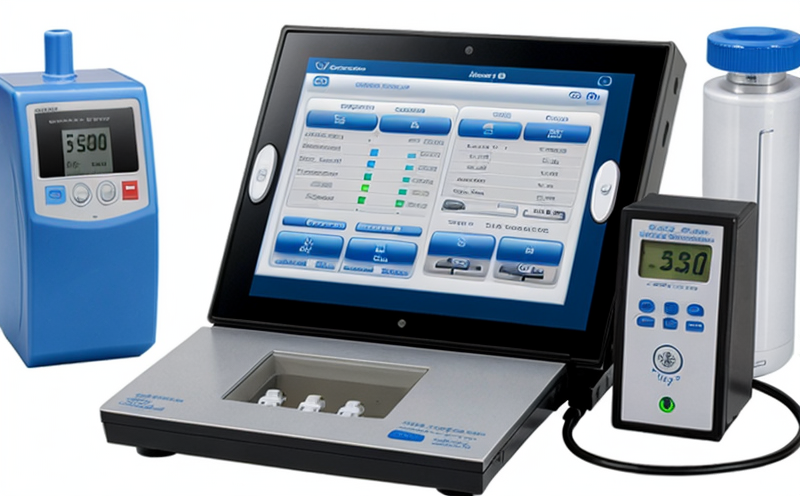ASTM D4169 Transport Simulation Testing of Infusion Systems
The ASTM D4169 standard is a critical component in the quality assurance process for medical devices, particularly those that are subject to transportation and handling conditions. This testing ensures that infusion pumps and drug delivery systems remain functional and safe under real-world conditions. In this section, we will delve into the specific parameters and methodologies used in ASTM D4169 transport simulation testing.
The test involves simulating the environmental stresses encountered during shipping and handling, such as temperature cycling, vibration, and shock. The objective is to assess whether the device can withstand these conditions without affecting its performance or safety. This is particularly important for infusion systems, which are critical medical devices that require precise operation at all times.
The testing process begins with careful preparation of the specimen. This includes selecting a representative sample of the infusion pump or drug delivery system to ensure that the test results are indicative of the entire population. Once prepared, the device is subjected to a series of environmental conditions designed to replicate actual shipping and handling scenarios.
Temperature cycling is one of the key components of this testing. The device is exposed to a range of temperatures, from extreme cold to hot, in cycles that mimic the transport conditions it might encounter. This helps determine if the device can operate correctly after being subjected to these temperature extremes.
Vibration and shock tests are also critical. These simulate the mechanical stresses caused by transportation on trucks or planes. The purpose is to ensure that the device remains functional even when subjected to significant shocks, such as those encountered during a rough landing or a jolt in transit.
The testing process is not just about ensuring the physical integrity of the device; it also focuses on its functionality and safety. After each test condition, the infusion pump or drug delivery system undergoes rigorous checks to ensure that it can still deliver medication accurately and safely. This includes checking for any changes in performance metrics such as flow rate, accuracy, and consistency.
The results of these tests are meticulously recorded and analyzed. Any deviation from acceptable limits is noted, and corrective actions are taken if necessary. The goal is not only to meet the standards set by ASTM D4169 but also to ensure that the device meets or exceeds the expectations of healthcare professionals and patients.
Understanding the importance of these tests is crucial for quality managers, compliance officers, R&D engineers, and procurement teams involved in the development and manufacturing of medical devices. By adhering to ASTM D4169 standards, manufacturers can ensure that their products are reliable and safe under real-world conditions, thereby enhancing patient care.
Why It Matters
The importance of transport simulation testing cannot be overstated in the medical device industry. Ensuring that infusion pumps and drug delivery systems function correctly during transportation is essential for maintaining patient safety and efficacy. Here are some key reasons why this testing is critical:
- Patient Safety: Ensures that medication is delivered accurately and safely.
- Device Reliability: Validates the device's performance under various environmental conditions.
- Compliance: Meets regulatory requirements, enhancing market access.
- Quality Assurance: Provides consistent results across different batches of devices.
The reliability of these tests is paramount. Any malfunction during transportation could lead to serious consequences for patients. Therefore, it's crucial that the testing process is rigorous and standardized.
Applied Standards
| Standard Code | Description |
|---|---|
| ASTM D4169 | Standard Practice for Transport Simulation Testing of Packaging. |
| ISO 2859-1 | Sampling plans for inspection by attributes – Part 1: Sampling procedures for sampling from a continuous process. |
The ASTM D4169 standard is the primary reference for transport simulation testing. It provides comprehensive guidelines on how to simulate and test the environmental stresses that medical devices might encounter during transportation. This includes temperature cycling, vibration, and shock tests. The ISO 2859-1 standard complements this by providing sampling plans for inspection by attributes, ensuring that representative samples are used in the testing process.
These standards ensure consistency and reliability in the testing process. By adhering to these guidelines, manufacturers can be confident that their products will meet regulatory requirements and perform reliably under real-world conditions.
Benefits
- Patient Safety: Ensures that medication is delivered accurately and safely during transportation.
- Device Reliability: Validates the device's performance under various environmental conditions.
- Compliance: Meets regulatory requirements, enhancing market access.
- Quality Assurance: Provides consistent results across different batches of devices.
- Risk Mitigation: Identifies potential issues before they impact patients.
- Cost Efficiency: Prevents costly recalls and reworks by ensuring product reliability upfront.
- Enhanced Reputation: Establishes a reputation for quality and reliability in the industry.
The benefits of transport simulation testing are far-reaching. By implementing ASTM D4169, manufacturers can ensure that their products meet stringent standards and perform reliably under real-world conditions. This not only enhances patient safety but also builds trust with healthcare professionals and patients alike.





